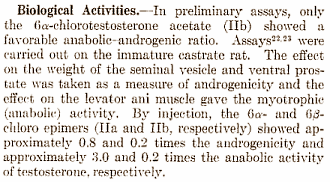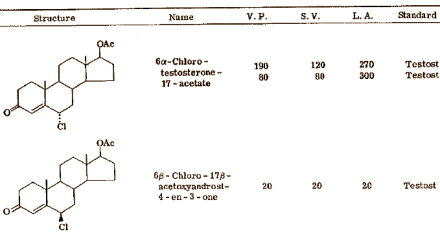|
Definition: "An ergogenic aid is any substance or phenomenon that enhances performance "
|
|
||||||||
12.08.2013 |
|
|
New designer steroid: 6-alpha-chloro-testosterone
As far as we know, there are now three designer supplements containing 6-alpha-chloro-testosteroner – full name: 6-alpha-chloro-androst-4-en-17-beta-ol-3-one – on the market. The first was Hexadrone, produced by Shredded Labs. According to the label, Hexadrone contains 50 mg 6-alpha-chloro-testosterone per cap. The manufacturer advises men to take 100 mg a day, and the recommended length for a course is maximum 4 weeks.
According to the label, Hexavar contains 15 mg 6-alpha-chloro-testosterone per cap. Shredded Labs markets this for women, and advises that they start with one cap per day. The recommended length for a course is maximum 4 weeks.
6-Alpha-Chloro-Testosterone was first synthesised in the early 1960s by chemists at the American pharmaceutical company Synthex. [J Med Chem. 1963 Mar;6:198-200.]
The researchers also made 6-beta-chloro-testosterone and assed the anabolic and androgenic effects of both new steroids. 6-Alpha-Chloro Testosterone was the most promising of the two, the researchers discovered. Its muscle building and anabolic effects were three times those of testosterone, while its masculinising and androgenic effects were twenty percent less.
A few years later, fellow researchers at Synthex studied 6-alpha-chloro-testosterone once again. [Acta Endocrinol (Copenh). 1964 Jun;46:300-6.] This time the androgenic effect of 6-alpha-chloro-testosterone was suddenly greater than that of testosterone. This explains the divergent data in Julius Vida's anabolic steroids bible, Androgens And Anabolic Agents, published in 1969.
VP = prostate; SV = seminal vesicle; LA = sphincter muscle. The effect of testosterone is set at 100.
The makers of Hexadrone and Hexavar say that 6-alpha-chloro-testosterone can't convert into a hormone with feminising properties. "Will not convert to estrogen", says Shredded Labs. "Immune to the effects of aromatase. Can be used as an aromatase inhibitor."
There is no research on the anti-oestrogenic effect of 6-alpha-chloro-testosterone, but we don't think that Shredded Labs is telling fibs. The related 6-alpha-fluoro-testosterone and 6-alpha-bromo-androstenedione both block the effects of aromatase, the enzyme that testosterone converts into estradiol.
The size and electrical charge of fluorine, bromine and chlorine groups are different, but according to researchers at the University of California that doesn't make much difference in this case. [Steroids. 1990 May;55(5):242-6.] In 1990 they published the results of an in-vitro study of the anti-oestrogenic effects of 6-alpha-fluorotestosterone.
"A fluorine substituent will withdraw electron density from neighboring bonds because of its high electronegativity and, in this way, might render aromatization unfavorable", the researchers write in that article. "To differentiate between effects of the bulk and electronegativity of the fluorine substituent, we tested 6-alpha-bromoandrostenedione for aromatization. Although 6-alpha-bromoandrostenedione binds to aromatase with high affinity, we found that its aromatization is also undetectable. Bromine is larger but less electronegative than fluorine; if a common mechanism is responsible, then steric bulk may play a greater role in the nonaromatizability of 6-alpha-halogenated androgens than electronegativity."
So there you have it. Is 6-alpha-chloro-testosterone an anti-oestrogen? It might just be.
Source:
More:
|
|






